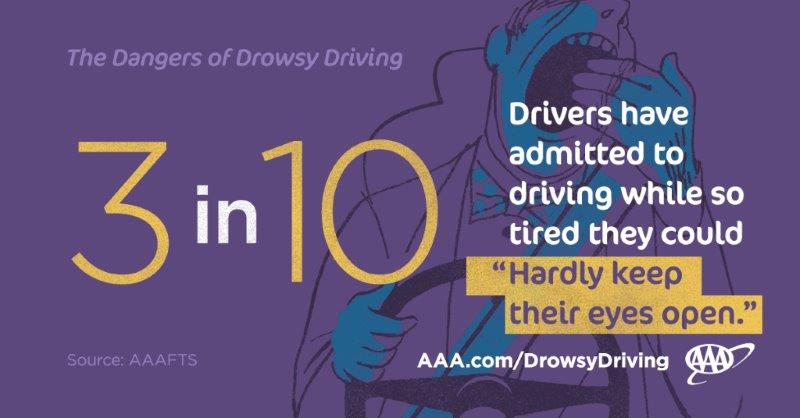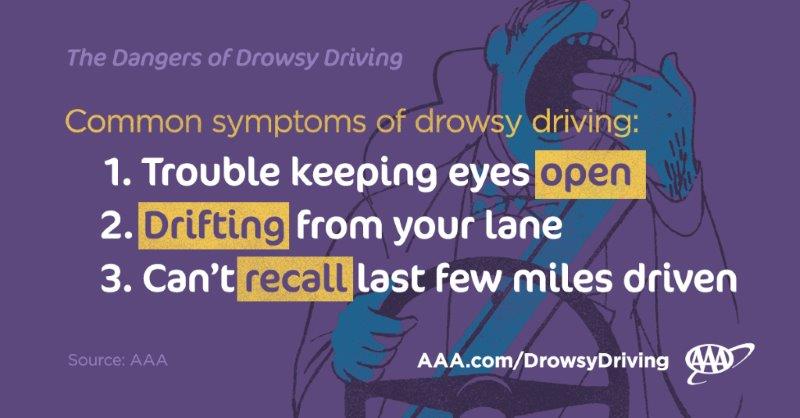New research by the AAA Foundation for Traffic Safety shows drowsy driving crashes are eight times higher than federal estimates
PORTLAND, Ore., – The most in-depth drowsy driving research ever conducted in the U.S. using footage of everyday drivers found that the percentage of crashes involving drowsiness is nearly eight times higher than federal estimates indicate, according to the AAA Foundation for Traffic Safety.
The difficulty in detecting drowsiness following a crash makes drowsy driving one of the most underreported traffic safety issues. The new research provides an unprecedented analysis of in-vehicle dashcam video from more than 700 crashes, confirming that the danger of drowsy driving soars above official estimates.
“Drowsy driving is a bigger traffic safety issue than federal estimates show,” said Dr. David Yang, executive director for the AAA Foundation for Traffic Safety. “Drivers who don’t get enough sleep are putting everyone on the road at risk. By conducting an in-depth analysis using video of everyday drivers, we can now better assess if a driver was fatigued in the moments leading up to a crash.”
In the study, researchers examined video of drivers’ faces in the three minutes leading up to a crash. Using a scientific measure linking the percentage of time a person’s eyes are closed to their level of drowsiness, the researchers determined that 9.5 percent of all crashes and 10.8 percent of crashes resulting in significant property damage involved drowsiness. Federal estimates indicate drowsiness is a factor in only one to two percent of crashes.
B roll video is available here and here.
The Centers for Disease Control and Prevention says that 35 percent of U.S. drivers sleep less than the recommended minimum of seven hours daily. In a 2016 AAA Foundation survey, nearly all drivers (96 percent) said they view drowsy driving as a serious threat to their safety and a completely unacceptable behavior. However, 29 percent admitted to driving when they were so tired they had a hard time keeping their eyes open at some point in the past month.

“Many of us routinely miss getting seven hours of sleep every night and that can put you, your passengers and those in other vehicles at risk on the road. Missing just two to three hours of sleep can more than quadruple your risk for a crash, which is the equivalent of driving drunk,” says Marie Dodds, public affairs director for AAA Oregon/Idaho.
Knowing the warning signs of drowsiness can help drivers avoid dozing off behind the wheel. The most common symptoms include:
- Having trouble keeping your eyes open
- Drifting from your lane
- Not remembering the last few miles driven

Drivers however should not rely on their bodies to provide warning signs for drowsiness and should instead prioritize getting at least seven hours of sleep before hitting the road.
“The only way to prevent drowsy driving is to get enough sleep,” adds Dodds. “Things like drinking coffee, rolling down the window, and singing may help you feel more awake temporarily, but eventually your body’s need for sleep will override your brain’s attempts to stay awake.”
AAA recommends that drivers:
- Travel at times of the day when they are normally awake
- Avoid heavy foods
- Avoid medications that cause drowsiness or other impairment
For longer trips, AAA says drivers should:
- Schedule a break every two hours or every 100 miles
- Travel with an alert passenger and take turns driving
- Take a short nap if you’re feeling sleepy! Pulling into a rest stop and taking a quick catnap—at least 20 minutes and no more than 30 minutes of sleep—can help to keep you alert on the road.
To help drivers determine if their medications may cause drowsiness, AAA and the AAA Foundation developed Roadwise Rx, a free and confidential online tool that generates personalized feedback about how the interactions between prescription, over-the-counter medicines and herbal supplements can affect safety behind the wheel.
The AAA Foundation for Traffic Safety’s report, Prevalence of Drowsy Driving Crashes: Estimates from a Large-Scale Naturalistic Driving Study, is based on the analysis of in-vehicle video footage of crashes that occurred during the Second Strategic Highway Research Program’s Naturalistic Driving Study (SHRP 2 NDS). The federally funded study recruited 3,593 drivers from six study sites across the U.S. The drivers were monitored continually using in-vehicle video and other data collection equipment while driving their personal vehicles for a period of several months.
About AAA Foundation for Traffic Safety: Established in 1947 by AAA, the AAA Foundation for Traffic Safety is a not-for-profit, publicly funded, 501(c)(3) charitable research and educational organization. The AAA Foundation’s mission is to prevent traffic deaths and injuries by conducting research into their causes and by educating the public about strategies to prevent crashes and reduce injuries when they do occur. This research is used to develop educational materials for drivers, pedestrians, bicyclists and other road users. Visit www.AAAFoundation.org.
About AAA: AAA provides more than 58 million members with automotive, travel, insurance and financial services through its federation of 36 motor clubs and nearly 1,100 branch offices across North America. Since 1902, the not-for-profit, fully tax-paying AAA has been a leader and advocate for safe mobility. Drivers can request roadside assistance, identify nearby gas prices, locate discounts, book a hotel or map a route via the AAA Mobile app. To join, visit AAA.com.
AAA news releases, high resolution images, broadcast-quality video, fact sheets and podcasts are available on the AAA NewsRoom at NewsRoom.AAA.com.

